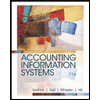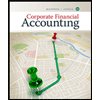
Real World Case 8–2
Physical quantities and costs included in inventory; Sport Chalet
• LO8–2
Real World Financials
Determining the physical quantity that should be included in inventory normally is a simple matter because that amount consists of items in the possession of the company. The cost of inventory includes all necessary expenditures to acquire the inventory and bring it to its desired condition and location for sale or for use in the manufacturing process.
Required:
1. Identify and describe the situations in which physical quantity included in inventory is more difficult than simply determining items in the possession of the company.
2. In addition to the direct acquisition costs such as the price paid and transportation costs to obtain inventory, what other expenditures might be necessary to bring the inventory to its desired condition and location?
3. Access EDGAR on the Internet. The web address is www.sec.gov. Search for Sport Chalet Inc., a leading operator of full-service, specialty sporting goods stores in California and Nevada. Access the 10-K filing for the most recent fiscal year. Search or scroll to find the disclosure notes (footnotes). What costs does Sport Chalet include in its inventory?
Want to see the full answer?
Check out a sample textbook solution
Chapter 8 Solutions
Intermediate Accounting
- Taron Productions has the following information from its process costing system: beginning work-in-process of 4,800 units (60% complete for conversion costs), 22,500 units started during the period, and ending work-in-process of 3,900 units (40% complete for conversion costs). Using the weighted average method, what are the equivalent units for conversion costs for the period?arrow_forwardCan you explain this general accounting question using accurate calculation methods?arrow_forwardI need assistance with this general accounting question using appropriate principles.arrow_forward
- Please provide the solution to this financial accounting question using proper accounting principles.arrow_forwardCan you help me solve this general accounting problem using the correct accounting process?arrow_forwardWhat is the amount includible in income in the first year of withdrawals assuming 12 monthly payments?arrow_forward
- I need help finding the accurate solution to this general accounting problem with valid methods.arrow_forwardPlease provide the solution to this general accounting question using proper accounting principles.arrow_forwardI need help finding the accurate solution to this general accounting problem with valid methods.arrow_forward
- Please give me answer with accounting questionarrow_forwardI am looking for the correct answer to this general accounting question with appropriate explanations.arrow_forwardGinga Marketing Group is a digital marketing business. At the end of its accounting period, December 31, 2023, Ginga had assets of $875,000 and liabilities of $320,000. Determine the net income (or loss) during 2024, assuming that as of December 31, 2024, assets were $960,000, liabilities were $290,000, and no additional capital stock was issued or dividends paid.arrow_forward
 Accounting Information SystemsFinanceISBN:9781337552127Author:Ulric J. Gelinas, Richard B. Dull, Patrick Wheeler, Mary Callahan HillPublisher:Cengage Learning
Accounting Information SystemsFinanceISBN:9781337552127Author:Ulric J. Gelinas, Richard B. Dull, Patrick Wheeler, Mary Callahan HillPublisher:Cengage Learning Financial & Managerial AccountingAccountingISBN:9781285866307Author:Carl Warren, James M. Reeve, Jonathan DuchacPublisher:Cengage Learning
Financial & Managerial AccountingAccountingISBN:9781285866307Author:Carl Warren, James M. Reeve, Jonathan DuchacPublisher:Cengage Learning Corporate Financial AccountingAccountingISBN:9781305653535Author:Carl Warren, James M. Reeve, Jonathan DuchacPublisher:Cengage Learning
Corporate Financial AccountingAccountingISBN:9781305653535Author:Carl Warren, James M. Reeve, Jonathan DuchacPublisher:Cengage Learning Corporate Financial AccountingAccountingISBN:9781337398169Author:Carl Warren, Jeff JonesPublisher:Cengage Learning
Corporate Financial AccountingAccountingISBN:9781337398169Author:Carl Warren, Jeff JonesPublisher:Cengage Learning Financial & Managerial AccountingAccountingISBN:9781337119207Author:Carl Warren, James M. Reeve, Jonathan DuchacPublisher:Cengage Learning
Financial & Managerial AccountingAccountingISBN:9781337119207Author:Carl Warren, James M. Reeve, Jonathan DuchacPublisher:Cengage Learning




